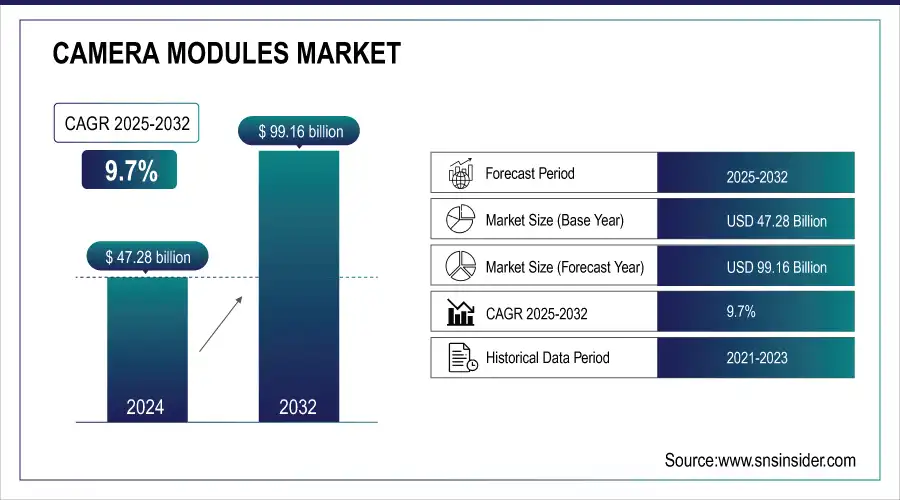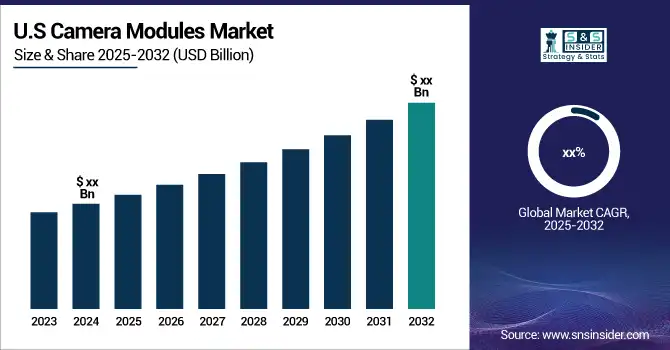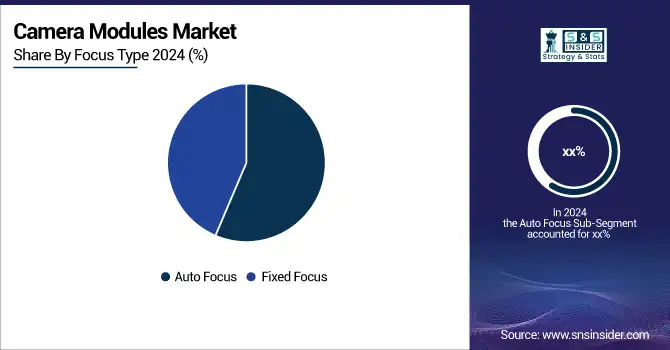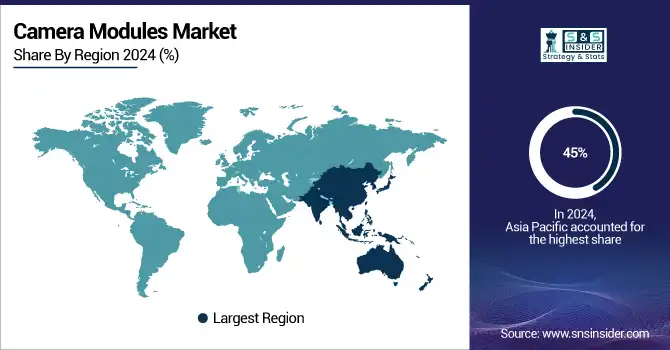Camera Modules Market Size:
The Camera Modules Market Size was valued at USD 47.28 billion in 2025E and is expected to reach USD 99.16 billion by 2033 and grow at a CAGR of 9.7% over the forecast period 2026-2033. The camera module market is doing very well which driven by the rise of smartphones autonomous vehicles and security systems. The increasing demand for high-quality photos and videos in smartphones is a major factor.
Market Size and Forecast:
-
Market Size in 2025E USD 47.28 Billion
-
Market Size by 2033 USD 99.16 Billion
-
CAGR of 9.7% From 2026 to 2033
-
Base Year 2025
-
Forecast Period 2026-2033
-
Historical Data 2022-2024

Get more information on Camera Modules Market - Request Sample Report
The ADAS market's adoption of self-driving cars is creating a huge need for advanced camera modules. In the security sector rising construction activities and growing concerns about security are propelling the demand for camera-based surveillance systems. This trend is expected to continue with the global car sales reaching 101.4 million units by next years and autonomous vehicles comprising 12% of registrations. The market scope extends beyond these sectors with applications in video conferencing real-time monitoring and even smart home appliances. Complexities in the camera module supply chain and higher costs in developing regions pose challenges. The overall market is expected to rise due to the ever-increasing demand for functionalities that camera modules provide. Government support for smart transportation like Japan's connected vehicles initiative fuels market growth for camera modules in autonomous vehicles. Beyond these core sectors applications in security conferencing and smart homes broaden the market scope. Advancements and strong demand promise a positive outlook for camera modules.
The U.S. Camera Modules market size was valued at an estimated USD 17.90 billion in 2025 and is projected to reach USD 37.85 billion by 2033, growing at a CAGR of 9.6% over the forecast period 2026–2033. Market growth is driven by strong demand from the smartphone and consumer electronics sectors, along with increasing adoption of advanced camera systems in automotive applications such as ADAS and autonomous vehicles. Rising use of camera modules in security and surveillance, industrial automation, and healthcare imaging further supports market expansion. Technological advancements including multi-camera setups, 3D sensing, and improved low-light performance, combined with the presence of leading technology companies and OEMs, continue to strengthen the U.S. camera modules market outlook during the forecast period.

Camera Modules Market Trends:
-
Integration of AI and advanced processors is enabling smarter, more capable camera modules in consumer electronics.
-
Rising consumer demand for electronic devices, including smartphones, wearables, and smart home products, drives camera module adoption.
-
Frequent device replacement cycles fueled by falling prices and new technologies are boosting camera module demand.
-
Innovations in image sensors are improving photo and video quality, low-light performance, and depth sensing for advanced features.
-
Expansion of e-commerce and logistics supports the proliferation of devices equipped with high-performance camera modules across multiple sectors.
Camera Modules Market Growth Drivers:
Advancements in technologies like artificial intelligence and high-speed processors are driving innovation across the consumer electronics and automotive industries. Consumers are purchasing and using more electronic devices, often replacing them frequently due to falling prices and the appeal of new technologies such as wearables and smart home products. A critical component in these devices is the camera module, with smartphones leading the trend of increasingly sophisticated camera systems. This emphasis on enhanced image quality and advanced features is extending to tablets, laptops, wearables, and gaming consoles, shaping the evolution of consumer electronics and driving demand for high-performance camera modules.
Camera Modules Market Restraints:
The trend of miniaturization in electronics is pushing the boundaries of device design, creating a need for innovative solutions in camera module development. These modules must seamlessly integrate with diverse hardware and software platforms across smartphones, wearables, laptops, and other devices, ensuring consistent performance and user experience. Achieving this level of integration and functionality requires a highly skilled workforce capable of driving continuous innovation in sensor technology, optics, and AI-powered imaging. As devices become smaller and more sophisticated, manufacturers must balance compact design with high performance, making expertise and technological innovation critical for success in the camera module market.
Camera Modules Market Opportunities:
The growth of online shopping and efficient delivery systems reflects the rapid expansion of the e-commerce and logistics sectors, driving demand for advanced electronic devices. Innovations in image sensor technology are enabling higher-quality photos and videos, making camera modules increasingly popular. Modern sensors capture sharper images, perform better in low-light conditions, and support depth-sensing features such as facial recognition. Additionally, these sensors are becoming smaller to fit a variety of devices and integrate seamlessly with technologies like artificial intelligence. Enhanced sensors lead to superior camera modules, which are now being incorporated into an ever-growing range of consumer and industrial applications.
Camera Modules Market Segment Analysis:
By Focus Type
In 2025, the Auto Focus segment dominated the Camera Modules Market due to its widespread adoption in smartphones, tablets, and high-end consumer electronics. Auto Focus modules allow for sharper and more precise imaging, enhancing user experience in photography and video recording. Their capability to automatically adjust to different lighting conditions and subject distances has made them the preferred choice for premium devices, contributing significantly to market revenue and establishing dominance over Fixed Focus modules.
From 2026 to 2033, the Fixed Focus segment is expected to register the fastest CAGR. Driven by increasing demand for cost-effective and compact camera solutions in wearables, IoT devices, and budget smartphones, Fixed Focus modules are gaining traction in emerging markets. Their simpler design, lower production cost, and compatibility with miniaturized devices make them an attractive option for manufacturers targeting affordability without compromising basic imaging functionality. This trend is anticipated to accelerate growth in the Fixed Focus segment over the forecast period.

By Component
In 2025, the Image Sensors segment dominated the Camera Modules Market, accounting for the largest revenue share. Image sensors are critical for capturing high-quality images and videos, and their advancement in resolution, low-light performance, and integration with AI technologies has driven widespread adoption across smartphones, laptops, wearables, and automotive devices. The continuous innovation in sensor technology has made this component indispensable, contributing significantly to market growth and establishing its dominance over other components such as lenses and interfaces.
From 2026 to 2033, the Voice Coil Motors (VCM) segment is expected to register the fastest CAGR. VCMs enable precise auto-focus functionality in compact camera modules, which is increasingly required in smartphones, tablets, and wearable devices. Growing demand for high-speed and accurate focusing mechanisms in multi-camera setups, coupled with miniaturization trends, is anticipated to drive rapid adoption of VCMs, making this segment a key growth area in the Camera Modules Market over the forecast period.
By Pixels
In 2025, the 8 to 13 MP segment dominated the Camera Modules Market, driven by its widespread use in smartphones, tablets, and consumer electronics. This pixel range offers a balance between high image quality and cost-effectiveness, making it ideal for mainstream devices. Its ability to deliver sharp images, good low-light performance, and compatibility with AI-driven imaging features contributed to its leading market share, outperforming lower and higher megapixel categories in terms of adoption and revenue generation.
From 2026 to 2033, the >13 MP segment is expected to register the fastest CAGR. Rising demand for premium smartphones, advanced tablets, high-resolution webcams, and specialized imaging devices is fueling growth in this segment. Consumers increasingly prefer higher megapixel cameras for better image clarity, detailed photography, and enhanced video recording capabilities. Additionally, technological advancements in sensor miniaturization and AI-enabled image processing are enabling manufacturers to integrate >13 MP modules into compact devices, accelerating adoption and driving significant market expansion during the forecast period.
By Interface
In 2025, the Camera Serial Interface (CSI) segment dominated the Camera Modules Market due to its widespread adoption in smartphones, tablets, laptops, and other compact devices. CSI offers faster data transmission, lower power consumption, and easier integration with modern processors, making it the preferred choice over the traditional Camera Parallel Interface (CPI). Its compatibility with high-resolution sensors and support for multi-camera setups has driven significant revenue and established its dominance in the market.
From 2026 to 2033, the Camera Parallel Interface (CPI) segment is expected to register the fastest CAGR. CPI continues to be used in cost-sensitive and industrial applications, such as automotive, surveillance, and IoT devices, where simpler and reliable interfaces are preferred. Increasing adoption in legacy systems and specialized devices, coupled with ongoing improvements to support higher speeds and resolutions, is expected to drive rapid growth in this segment over the forecast period.
By Application
In 2025, the Consumer Electronics segment dominated the Camera Modules Market, driven by the widespread use of smartphones, tablets, laptops, and wearables. High demand for advanced imaging features, such as multi-camera setups, AI-based photography, and high-resolution video recording, has fueled adoption. Continuous innovations in image sensors, miniaturization, and integration with AI technologies have further strengthened this segment’s market leadership and revenue contribution.
From 2026 to 2033, the Automotive segment is expected to register the fastest CAGR. The growing adoption of advanced driver-assistance systems (ADAS), in-cabin monitoring, autonomous driving technologies, and rear-view and surround-view camera systems is driving demand. Increasing vehicle electrification, smart mobility initiatives, and government safety regulations are encouraging the integration of sophisticated camera modules in automobiles, leading to rapid growth in this segment during the forecast period.
Camera Modules Market Regional Analysis:
Asia Pacific Camera Modules Market Insights
In 2025, the Asia Pacific region is leading the camera module market and is expected to stay ahead of the pack which holds the dominant position in market by 45%. This is because several big camera module makers like LG Innotek are based in APAC. The growing populations in these countries especially with rising smartphone ownership are also increasing the demand for camera modules. Even governments are getting involved with some taking steps to require cameras in new cars which creates another opportunity for camera module makers in APAC.

Get Customized Report as per your Business Requirement - Request For Customized Report
North America Camera Modules Market Insights
The North America camera modules market is driven by strong adoption in smartphones, automotive, and security applications. Growth is supported by innovations in AI-enabled imaging, autonomous driving technologies, and demand for high-resolution consumer electronics. Established semiconductor players and tech firms contribute to robust R&D investments, ensuring the region remains at the forefront of imaging and sensor integration.
Europe Camera Modules Market Insights
Europe’s camera modules market benefits from rising automotive applications, particularly in advanced driver-assistance systems (ADAS) and autonomous driving. Strong demand for high-quality imaging in healthcare devices and surveillance systems further supports growth. Government regulations promoting vehicle safety and smart infrastructure enhance adoption, while collaborations between tech firms and automotive manufacturers accelerate innovation in imaging solutions across the region.
Latin America (LATAM) and Middle East & Africa (MEA) Camera Modules Market Insights
The LATAM and MEA camera modules market is witnessing gradual growth fueled by rising smartphone penetration, security needs, and emerging automotive applications. Increasing adoption of connected devices, smart city initiatives, and surveillance systems drive demand. Although market maturity is lower compared to developed regions, expanding telecom infrastructure and consumer electronics adoption present significant opportunities for future growth.
Camera Modules Market Key Players:
- OFILM Group
- Sunny Optical Technology
- Samsung Electro-Mechanics
- Q Technology
- LG Innotek
- Hon Hai Precision
- Luxvision Innovation Limited
- AMS AG
- MCNEX Co
- Cammsys Corp
- Chicony Electronics
- Truly International Holdings
- Primax Electronics
Competitive Landscape for Camera Modules Market:
MCNEX is a leading South Korean manufacturer specializing in advanced camera modules, particularly for smartphones, automotive, and security applications. The company supplies major global brands with high-quality imaging solutions, leveraging expertise in image sensors, lens modules, and driver assistance systems. With growing demand for automotive safety and consumer electronics, MCNEX continues to innovate and expand its footprint in the global camera modules market.
In September 2023: MCNEX has teamed up with Corephotonics a company Samsung bought that holds important multi-camera patents to create a new camera system for self-driving cars. This 8MP DUAL SCANNING CAMERA is an advanced driver assistance system (ADAS) designed to specifically address blind spot detection, a major challenge for autonomous vehicles.
Samsung Electro-Mechanics is a key global player in the camera modules market, providing advanced imaging solutions for smartphones, tablets, automotive, and industrial applications. Leveraging its strong R&D and manufacturing capabilities, Samsung delivers high-resolution, miniaturized, and AI-enabled camera modules. The company’s leadership in consumer electronics and integration of innovative sensor technologies position it as a major driver of market growth worldwide.
In November 2023: Samsung's Good Lock app got an upgrade for the Camera Assistant module, offering new features for users with One UI 5.1 and above. This update lets you improve zoomed-in photos and automatically corrects distorted lines in your pictures. It also allows you to tweak camera settings not normally accessible in the default camera app.
| Report Attributes | Details |
|---|---|
| Market Size in 2025E | USD 47.28 Billion |
| Market Size by 2033 | USD 99.16 Billion |
| CAGR | CAGR of 9.7% From 2026 to 2033 |
| Base Year | 2025 |
| Forecast Period | 2026-2033 |
| Historical Data | 2022-2024 |
| Report Scope & Coverage | Market Size, Segments Analysis, Competitive Landscape, Regional Analysis, DROC & SWOT Analysis, Forecast Outlook |
| Key Segments | • By Focus Type (Auto Focus, Fixed Focus) • By Components (Image Sensors, Voice Coil Motors, Lens Module, Others) • By Interface (Camera Parallel Interface, Camera Serial Interface) • By Pixcels (Up To 7 MP, 8 To 13 MP, >13 MP) • By Application (Consumer Electronics, Healthcare, Security And Surveillance, Automotive, Industrial, Aerospace & Defense) |
| Regional Analysis/Coverage | North America (US, Canada), Europe (Germany, UK, France, Italy, Spain, Russia, Poland, Rest of Europe), Asia Pacific (China, India, Japan, South Korea, Australia, ASEAN Countries, Rest of Asia Pacific), Middle East & Africa (UAE, Saudi Arabia, Qatar, South Africa, Rest of Middle East & Africa), Latin America (Brazil, Argentina, Mexico, Colombia, Rest of Latin America). |
| Company Profiles | OFILM Group, Sunny Optical Technology, Samsung Electro-Mechanics, Q Technology, LG Innotek, Hon Hai Precision, Luxvision Innovation Limited, AMS AG, MCNEX Co, Cammsys Corp, Chicony Electronics, Truly International Holdings, Primax Electronics and Others |

